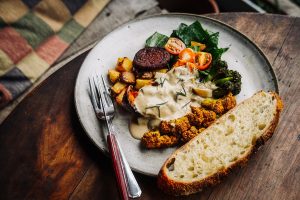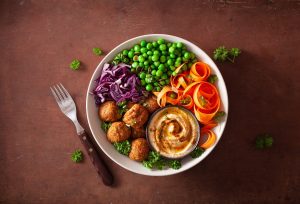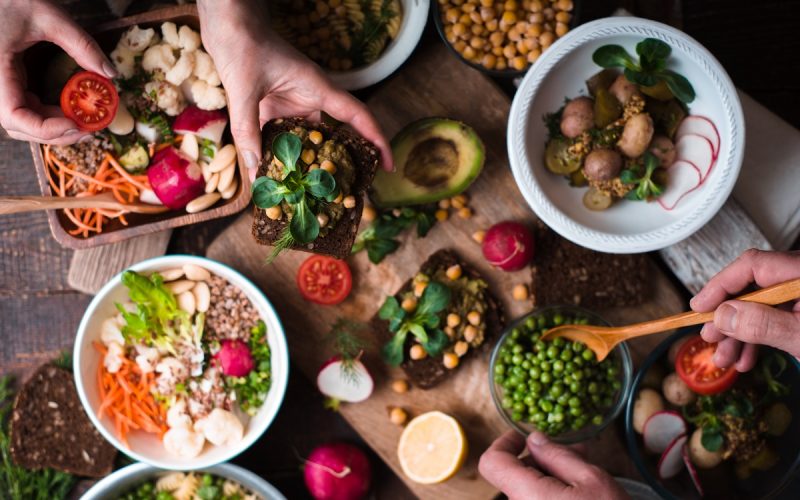It’s often believed that preparing a balanced vegan meal is challenging, but the plate method makes it simple. Imagine your plate filled with colorful ingredients: vegetables, grains, and plant proteins.
Half the plate should be vegetables, one-quarter grains, and the other quarter protein. This simple approach makes it easy to balance your nutritional intake. Grains like quinoa or brown rice pair perfectly with protein-rich foods like lentils or tofu.
These foods provide energy and brighten up your meals. Let’s enjoy this journey of delicious plant-based eating together.
1. Balancing Macronutrients: Proteins, Carbs, and Fats
The right combination of proteins, carbs, and fats is the foundation of a balanced vegan meal plan. Here’s a closer look at how these macronutrients work together to fuel your body and support a healthy vegan diet.
Plant-Based Protein Sources
 Protein is important for muscle health and keeping you satisfied. On a vegan diet, legumes like lentils, chickpeas, and black beans are excellent sources, offering fiber along with protein. Tofu and tempeh are versatile options, while quinoa and nuts provide both protein and healthy fats. For a meat-like texture, you can try plant-based meat substitutes.
Protein is important for muscle health and keeping you satisfied. On a vegan diet, legumes like lentils, chickpeas, and black beans are excellent sources, offering fiber along with protein. Tofu and tempeh are versatile options, while quinoa and nuts provide both protein and healthy fats. For a meat-like texture, you can try plant-based meat substitutes.
If you lead an active lifestyle, aim for 1.4 to 2.0 grams of protein per kilogram of body weight each day. Since protein contains four calories per gram, it’s an important part of any balanced vegan diet.
Complex Carbohydrates for Energy
Healthy carbs, such as brown rice, oats, and whole-grain bread, provide steady energy throughout the day without the blood sugar spikes that come from refined grains and sugars. Starchy vegetables like sweet potatoes and squash also offer satisfying energy and are ideal for vegan meals.
Carbohydrates contain four calories per gram, so portion size matters. For example, one cup of cooked quinoa provides 40g of carbohydrates, 8g of protein, and 4g of fat, making it an excellent, nutrient-rich choice.
Healthy Fats for Flavor and Nutrition
Fat is essential for flavor and helps your body absorb fat-soluble vitamins. Healthy fats from avocados, nuts, and seeds should be part of your daily meals. For cooking, choose plant-based oils like olive or coconut oil.
Vegan diets are often lower in saturated fats, but it’s important to watch out for trans fats in some processed foods. Healthy fats have the highest calorie content, with 9 calories per gram, so use them to boost flavor and nutrition.
2. Incorporating Vitamins and Minerals
A balanced vegan meal provides essential vitamins and minerals to maintain good health. Consider your meal like a jigsaw puzzle where every piece fits perfectly to meet your nutritional needs.
Calcium for Strong Bones
 Calcium is key for developing strong bones. A good vegan diet includes calcium-rich foods like fortified plant milk, leafy greens like kale, and tofu. Almonds and sesame seeds also offer a good dose of calcium.
Calcium is key for developing strong bones. A good vegan diet includes calcium-rich foods like fortified plant milk, leafy greens like kale, and tofu. Almonds and sesame seeds also offer a good dose of calcium.
To enhance calcium absorption, make sure you’re getting enough vitamin D, which can be obtained from sunlight or fortified foods. Staying updated on nutrition guidelines will help you meet your calcium needs.
Improving Iron Absorption
Iron is vital for oxygen transport in your blood. Vegans should focus on iron-rich foods such as lentils and spinach. Pair these with foods high in vitamin C, like oranges or bell peppers, to increase iron absorption. Regularly reviewing your meal plan will help ensure you’re meeting your iron requirements and prevent deficiencies.
Maintaining B12 and Omega-3 Levels
Vitamin B12 is important for preventing anemia and supporting nerve function. Since B12 is not naturally found in plant foods, include fortified foods or take supplements. Omega-3 fatty acids, essential for heart health, can be sourced from algae-based supplements or seeds like chia and flax. With careful planning, you can meet your vegan diet’s B12 and omega-3 requirements.
3. Creating Well-Rounded and Flavorful Meals
To make delicious, balanced meals, focus on using a variety of colors, whole grains, and plant proteins. Adding fresh herbs, spices, and healthy fats will elevate the flavor and texture of your dishes.
Building a Colorful Plate
A colorful plate doesn’t just look appealing; it’s also packed with nutrients. Mixing foods like spinach, peppers, and corn creates a beautiful, healthy plate. Incorporate a variety of colorful foods—tomatoes, carrots, cabbage—because each color provides unique health benefits.
For instance, red foods are good for heart health, while green foods aid in detoxification. Eating colorful meals not only promotes health but also makes mealtime more exciting.
Enhancing Flavor with Herbs and Spices
 Herbs and spices are your secret weapon for flavorful vegan dishes. They add taste without adding calories or sodium. For example, basil complements tomato salad, and cumin enhances bean stews.
Herbs and spices are your secret weapon for flavorful vegan dishes. They add taste without adding calories or sodium. For example, basil complements tomato salad, and cumin enhances bean stews.
Experiment with new combinations, like coriander and lime or sweet potato and cinnamon. Many spices, like turmeric, also offer health benefits, making your meals both delicious and nutritious.
Planning Portions and Meal Prep
Meal prep helps you maintain a balanced diet while saving time during the week. By preparing meals in advance, you can avoid the stress of cooking on busy weekdays. Use the “power plate” method, as recommended by the American Dietetic Association: fill half your plate with fruits and vegetables, one-quarter with whole grains, and one-quarter with protein-rich foods like beans. This approach will help you balance your meals and make the most of your time for other activities.
Prepare Your Healthy Vegan Eating Plan!
Creating a flavorful vegan diet that combines proteins, carbs, fats, vitamins, and minerals is easy when you plan ahead. Just like writing a song, each ingredient plays its part. Don’t be afraid to get creative with grains, greens, healthy fats, and spices.
Going vegan doesn’t mean limiting your options—it’s about discovering new ways to cook and enjoy food. When you find meals that your friends and family love, share them so everyone can enjoy balanced, delicious vegan meals. Most importantly, have fun in the kitchen—you can’t go wrong when you’re preparing healthy, plant-based food.
Stay informed with Whole Foods Voice for guides and for the latest updates and insights on plant-based eating!

